Challenges in the Digitization of Apprenticeships during the Coronavirus Pandemic: Who Needs Special Assistance?
Abstract
:1. Introduction
2. Theoretical Background
2.1. Digital Learning
2.2. Importance of the Learning Space
3. Current State of Research
3.1. Digitization in Dual Vocational Training
3.2. First School Closure during the Coronavirus Pandemic
4. Data and Method
4.1. Challenges by Surveying Adolescents
4.2. Data
4.2.1. Respondents
4.2.2. Survey Design and Data Collection
4.2.3. Measures
4.3. Method
5. Quantitative Results
5.1. Sociodemographics
5.2. Changes in the Situation in the Vocational School
5.3. Digital Equipment Available to Apprentices
5.4. Change in School Performance
6. Qualitative Results
7. Conclusions
7.1. Summary
7.2. Discussion
7.2.1. Practical Implications
7.2.2. Limitations and Future Research
Author Contributions
Funding
Institutional Review Board Statement
Informed Consent Statement
Data Availability Statement
Conflicts of Interest
Appendix A
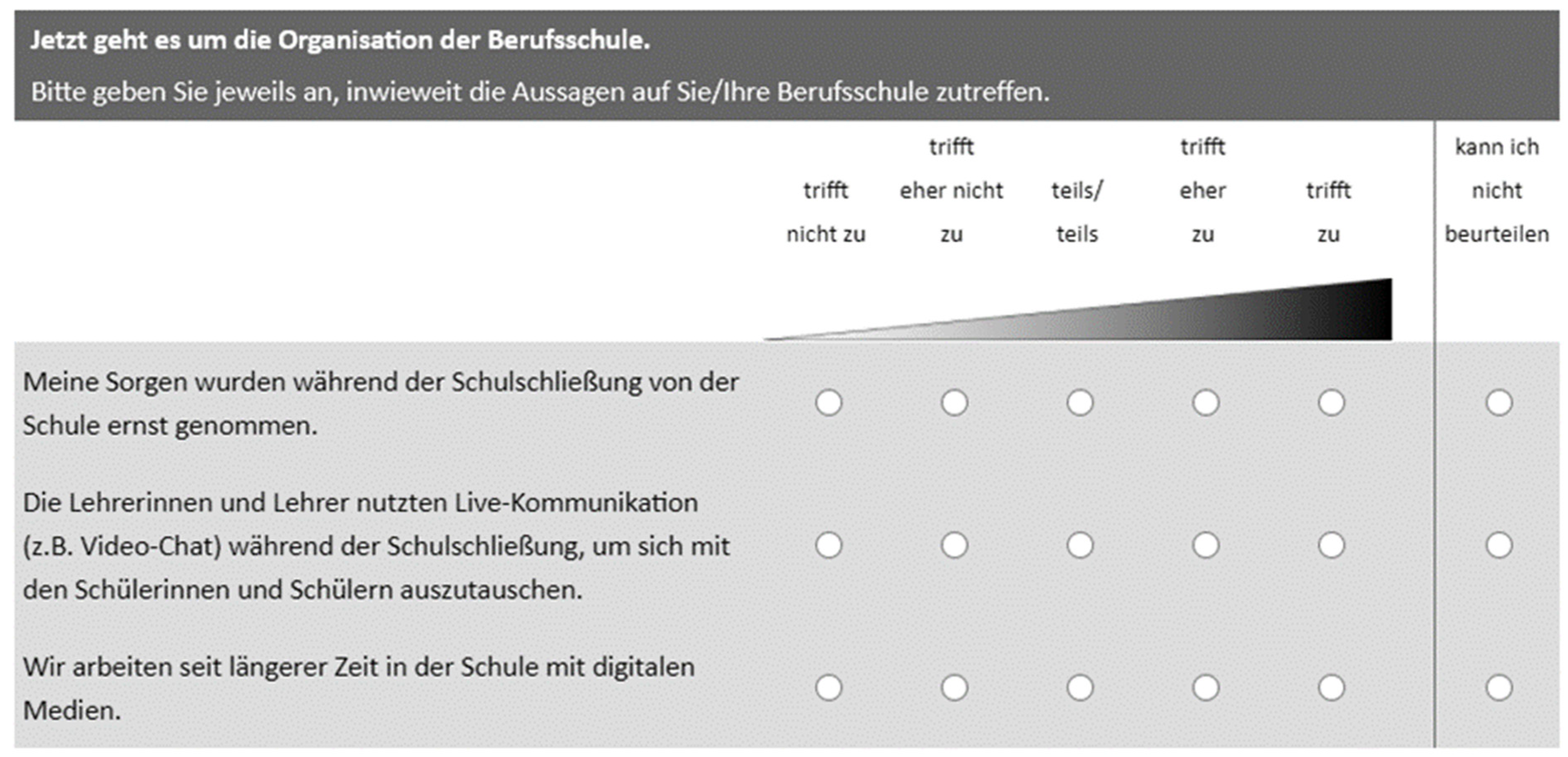

References
- Garrote, A.; Neuenschwander, M.; Hofmann, J.; Mayland, C.; Niederbacher, E.; Prieth, V.; Rösti, I. Fernunterricht Während der Coronavirus-Pandemie: Analyse von Herausforderungen und Gelingensbedingungen [Distance Education during the Coronavirus Pandemic: Analysis of Challenges and Conditions for Success]; University of Applied Sciences Northwestern Switzerland (FHNW): Windisch, Switzerland, 2021. [Google Scholar] [CrossRef]
- Van Ackeren, I.; Endberg, M.; Locker-Grütjen, O. Chancenausgleich in der Corona-Krise: Die soziale Bildungsschere wieder schließen [Equalizing opportunities in the Corona crisis: Closing the social education gap]. DDS Die Dtsch. Sch. 2020, 112, 245–248. [Google Scholar] [CrossRef]
- Unger, V.; Krämer, Y.; Wacker, A. Unterricht während der Corona-Pandemie [Education during the Corona pandemic]. Z. Schul-Prof. 2020, 2, 84–99. [Google Scholar] [CrossRef]
- González-Betancor, S.M.; López-Puig, A.J.; Cardenal, M.E. Digital inequality at home. The school as compensatory agent. Comput. Educ. 2021, 168, 104195. [Google Scholar] [CrossRef]
- Tengler, K.; Schrammel, N.; Brandhofer, G. Lernen trotz Corona. Chancen und Herausforderungen des distance learning an österreichischen Schulen [Learning despite Corona. Opportunities and Challenges of Distance Learning in Austrian Schools.]. Medienimpulse 2020, 58, 37. [Google Scholar] [CrossRef]
- Huebener, M.; Schmitz, L. Corona-Schulschließungen: Verlieren Leistungsschwächere SchülerInnen den Anschluss? [Coronavirus School Closures: Are Lower-Performing Students Losing Out?]; DIW: Berlin, Germany, 2020; Available online: http://hdl.handle.net/10419/216975 (accessed on 30 September 2021).
- Lackner, E.; Kopp, M. Lernen und Lehren im virtuellen Raum Herausforderungen, Chancen, Möglichkeiten [Learning and teaching in virtual space. Challenges, opportunities, possibilities]. In Lernräume Gestalten–Bildungskontexte Vielfaltig Denken [Designing Learning Spaces–Thinking Educational Contexts Manifoldly]; Rummler, K., Ed.; Waxmann Verlag GmbH: Münster, Germany, 2014; pp. 174–186. ISBN 978-3-8309-3142-3. [Google Scholar]
- Biebeler, H.; Schreiber, D. Ausbildung in Zeiten von Corona. Ergebnisse einer Empirischen Studie zu Auswirkungen der Corona-Pandemie auf Ausbildungsbetriebe [Apprenticeships in Times of Corona. Results of an Empirical Study on the Impact of the Coronavirus Pandemic on Apprenticeship Companies]; Bundesinstitut für Berufsbildung [Federal Institute for Vocational Education and Training]: Bonn, Germany, 2020. [Google Scholar]
- Unger, A. Lernumgebung upside down. Eine Auseinandersetzung mit der persönlichen Lernumgebung im Kontext des medienbasierten Lernens [Learning environment upside down. An examination of the personal learning environment in the context of media-based learning]. In Lernräume Gestalten–Bildungskontexte Vielfaltig Denken [Designing Learning Spaces–Thinking Educational Contexts Manifoldly]; Rummler, K., Ed.; Waxmann Verlag GmbH: Münster, Germany, 2014; pp. 79–90. ISBN 978-3-8309-3142-3. [Google Scholar]
- Klös, H.-P.; Seyda, S.; Werner, D. Berufliche Qualifizierung und Digitalisierung: Eine Empirische Bestandsaufnahme [Vocational Qualification and Digitalization: An Empirical Review]; IW-Report No. 40; Institut der Deutschen Wirtschaft (IW): Cologne, Germany, 2020; Available online: http://hdl.handle.net/10419/223203 (accessed on 30 September 2021).
- Flake, R.; Meinhard, D.B.; Werner, D. Digitalisierung in der dualen Berufsausbildung: Umsetzungsstand, Modernisierungs-und Unterstützungsbedarf in Betrieben [Digitalization in apprenticeship: Implementation status, need for modernization and support in companies]. IW-Trends-Vierteljahresschr. Zur Empir. Wirtsch. 2019, 46, 3–21. [Google Scholar]
- Ebbinghaus, M. Themenradar Duale Berufsausbildung-Frühjahr 2018: Ergebnisse der Dritten Befragungswelle zur Relevanz Ausgewählter Themen der Dualen Berufsausbildung Mit Dem BIBB-Expertenmonitor Berufliche Bildung [Thematic Device Dual Vocational Training Spring 2018: Results of the Third Survey Wave on the Relevance of Selected Topics of Apprenticeship with the BIBB Expert Monitor Vocational Education and Training]; Bundesinstitut für Berufsbildung [Federal Institute for Vocational Education and Training]: Bonn, Germany, 2018; ISBN 978-3-96208-076-1. [Google Scholar]
- Neuburg, C.; Schlenker, L.; Köhler, T. Wie Digital ist die Berufsschule? Eine Analyse Anhand von Online-Berichtsheften [How Digital Is the Vocational School? An Analysis Based on Online Report Cards]: Beiträge der 22. GeNeMe–Konferenz Gemeinschaften in Neuen Medien [Contributions of the 22nd GeNeMe–Conference Communities in New Media]; TUDpress: Dresden, Germany, 2019. [Google Scholar]
- Andresen, S.; Lips, A.; Möller, R.; Rusack, T.; Schröer, W.; Thomas, S.; Wilmes, J. Erfahrungen und Perspektiven von Jungen Menschen Während der Corona-Maßnahmen [Experiences and Perspectives of Young People during the Corona Interventions]; Universitätsverlag Hildesheim: Hildesheim, Germany, 2020. [Google Scholar]
- Brandt, P. Corona und die Ausbildungssituation [Corona and the apprenticeship situation]. Ifo Schnelld. 2020, 73, 44–45. [Google Scholar]
- Ebbinghaus, M. Welche Auswirkungen hat die Corona-Pandemie auf Betriebe und ihre Ausbildung? ZBW 2021, 117, 101. [Google Scholar] [CrossRef]
- Anger, S.; Dietrich, H.; Patzina, A.; Sandner, M.; Lerche, A.; Bernhard, S.; Toussaint, C. School closings during the COVID-19 pandemic: Findings from German high school students. In IAB-Forum; Institute for Employment Research of the Federal Employment Agency: Nuremberg, Germany, 2020. [Google Scholar]
- Delcker, J.; Ifenthaler, D. Teachers’ perspective on school development at German vocational schools during the COVID-19 pandemic. Technol. Pedagog. Educ. 2021, 30, 125–139. [Google Scholar] [CrossRef]
- Illan, L. Bildungsföderalismus in Zeiten der Corona-Krise [Education Federalism in Times of Corona Crisis]. GWP Gesellschaft. Wirtschaft. Politik 2020, 69, 9–10. [Google Scholar] [CrossRef]
- Niemi, H.M.; Kousa, P. A Case Study of Students’ and Teachers’ Perceptions in a Finnish High School during the COVID Pandemic. Int. J. Technol. Educ. Sci. IJTES 2020, 4, 352–369. [Google Scholar] [CrossRef]
- Dietrich, H.; Patzina, A.; Lerche, A. Social inequality in the homeschooling efforts of German high school students during a school closing period. Eur. Soc. 2021, 23, S348–S369. [Google Scholar] [CrossRef]
- Mauroux, L.; Könings, K.D.; Zufferey, J.D.; Gurtner, J.-L. Mobile and Online Learning Journal: Effects on Apprentices’ Reflection in Vocational Education and Training. Vocat. Learn. 2014, 7, 215–239. [Google Scholar] [CrossRef]
- Drabowicz, T. Gender and digital usage inequality among adolescents: A comparative study of 39 countries. Comput. Educ. 2014, 74, 98–111. [Google Scholar] [CrossRef]
- Korlat, S.; Kollmayer, M.; Holzer, J.; Lüftenegger, M.; Pelikan, E.R.; Schober, B.; Spiel, C. Gender Differences in Digital Learning During COVID-19: Competence Beliefs, Intrinsic Value, Learning Engagement, and Perceived Teacher Support. Front. Psychol. 2021, 12, 637776. [Google Scholar] [CrossRef] [PubMed]
- Hansen, C.; Plank, K.E. Vom Digital Divide zum Digital Bridging: Bildungschance Corona? [From Digital Divide to Digital Bridging: Educational Opportunity Corona?]. In Corona: Krise Oder Wende? Wie Krisen Kulturen Verunsichern und Verändern [Corona: Crisis or Change? How Crises Unsettle and Change Cultures9: Beiheft 24/2020; Hertrampf, M.O.M., Ed.; PhiN. Philologie im Netz: Berlin, Germany, 2020; ISBN 1436-7211. [Google Scholar]
- Bundesministerium für Bildung und Forschung. Berufsbildungsbericht 2020 [Vocational Training Report 2020]; Bundesministerium für Bildung und Forschun: Bonn, Germany, 2020; Available online: https://www.bmbf.de/upload_filestore/pub/Berufsbildungsbericht_2020.pdf (accessed on 8 April 2021).
- Anger, C.; Plünnecke, A. Homeschooling und Bildungsgerechtigkeit [Homeschooling and Educational Equity]: IW-Kurzbericht Nr. 44; Institution der Deutschen Wirtschaft (Institution of the German Economy): Cologne, Germany, 2020; Available online: https://www.iwkoeln.de/fileadmin/user_upload/Studien/Kurzberichte/PDF/2020/IW-Kurzbericht_2020_Homeschooling.pdf (accessed on 30 September 2021).
- Nusser, L.; Wolter, I.; Attig, M.; Fackler, S. Die Schulschließungen aus Sicht der Eltern. Ergebnisse des längsschnittlichen Nationalen Bildungspanels uns seiner Covid-19-Zusatzbefragung [School closures as perceived by parents. Results from the Longitudinal National Education Panel and its COVID-19 Supplementary Survey.]. In Schule Während der Corona-Pandemie. Neue Ergebnisse und Überblick über Ein Dynamisches Forschungsfeld [School during the Coronavirus Pandemic. New Results and Overview of a Dynamic Field of Research]; Fickermann, D., Edelstein, B., Eds.; Waxmann Verlag GmbH: Münster, Germany, 2021; ISBN 9783830943310. [Google Scholar]
- Grewenig, E.; Lergetporer, P.; Werner, K.; Woessmann, L.; Zierow, L. COVID-19 and Educational Inequality: How School Closures Affect Low-and High-Achieving Students; Discussion Paper No. 260; Munich and Berlin, 2020. Available online: https://www.econstor.eu/handle/10419/233484 (accessed on 30 September 2021).
- Schult, J.; Lindner, M.A. Did Students Learn Less during the COVID-19 Pandemic? Reading and Mathematics Competencies before and after the First Pandemic Wave. 2021. Available online: https://psyarxiv.com/pqtgf/download (accessed on 30 September 2021).
- Zierer, K. Effects of Pandemic-Related School Closures on Pupils’ Performance and Learning in Selected Countries: A Rapid Review. Educ. Sci. 2021, 11, 252. [Google Scholar] [CrossRef]
- DGB Abteilung Jugend und Jugendpolitik. Corona-Ausbildungsstudie [Study on Apprenticeship during the Coronavirus Pandemic]; DGB Abteilung Jugend und Jugendpolitik: Berlin, Germany, 2021; Available online: https://www.dgb.de/bundestagswahl-2021/wahlcheck/bildung/++co++89917d9e-04ea-11ec-9c96-001a4a160123 (accessed on 26 August 2021).
- Oberwittler, D.; Naplava, T. Auswirkungen des Erhebungsverfahrens bei Jugendbefragungen zu ‘heiklen’ Themen: Schulbasierte schriftliche Befragung und haushaltsbasierte mündliche Befragung im Vergleich [Impacts of the survey method during youth surveys regarding ‘awkward’ subjects: A comparison of a school-based written survey and a household-based oral survey]. ZUMA Nachr. 2002, 26, 60–88. [Google Scholar]
- Nachtsheim, J.; König, S. Befragungen von Kindern und Jugendlichen [Surveys of children and adolescents]. In Handbuch Methoden der Empirischen Sozialforschung [Manual of Methods of Empirical Social Research]; Baur, N., Blasius, J., Eds.; Springer Fachmedien Wiesbaden: Wiesbaden, Germany, 2019; pp. 927–933. ISBN 978-3-658-21308-4. [Google Scholar]
- Simonson, J. Klassenzimmerbefragungen von Kindern und Jugendlichen: Praktikabilität, Potentiale und Probleme einer Methode [Classroom surveys of children and adolescents: Practicability, potentials and problems of a method]. In Umfrageforschung. Herausforderungen und Grenzen [Survey Research. Challenges and Limitations]; Weichbold, M., Bacher, J., Wolf, C., Eds.; Springer VS Verlag für Sozialwissenschaften/GWV Fachverlage GmbH Wiesbaden: Wiesbaden, Germany, 2009; pp. 63–84. ISBN 978-3-531-91852-5. [Google Scholar]
- Christian, L.M.; Dillman, D.A. The influence of graphical and symbolic language manipulations on responses to self-administered questions. Public Opin. Q. 2004, 68, 57–80. [Google Scholar] [CrossRef]
- Mavletova, A. Web surveys among children and adolescents: Is there a gamification effect? Soc. Sci. Comput. Rev. 2015, 33, 372–398. [Google Scholar] [CrossRef] [Green Version]
- Stange, M.; Barry, A.; Smyth, J.; Olson, K. Effects of smiley face scales on visual processing of satisfaction questions in web surveys. Soc. Sci. Comput. Rev. 2018, 36, 756–766. [Google Scholar] [CrossRef]
- Toepoel, V.; Vermeeren, B.; Metin, B. Smileys, stars, hearts, buttons, tiles or grids: Influence of response format on substantive response, questionnaire experience and response time. Bull. Sociol. Methodol. Bull. Méthodol. Soc. 2019, 142, 57–74. [Google Scholar] [CrossRef] [Green Version]
- Heim, R.; Konowalczyk, S.; Grgic, M.; Seyda, M.; Burrmann, U.; Rauschenbach, T. Geht’s auch mit der Maus?–Eine Methodenstudie zu Online-Befragungen in der Jugendforschung [Can you do it with the mouse? A Methodological Study of Online Surveys in Youth Researchng: Educational Opportunity Corona?]. Z. Für Erzieh. 2016, 19, 783–805. [Google Scholar] [CrossRef]
- Cohen, J. Statistical Power Analysis for the Behavioral Sciences, 2nd ed.; Taylor and Francis: Hoboken, NJ, USA, 2013; ISBN 0-8058-0283-5. [Google Scholar]
- Vatuch, J.; Dembowski, H.; Teräs, M.; Eiriksdottir, E.; Marhuenda Fluixà, F.; Matseleng Allais, S.; Lopez Saldana, R.; Ha, P.V. Impacts of the coronavirus pandemic on vocational education and training: Snapshots from eight countries. In Impacts of the Coronavirus Pandemic; Federal Institute for Vocational Education and Training: Bonn, Germany, 2021; pp. 10–14. Available online: https://www.bwp-zeitschrift.de/en/bwp_136949.php (accessed on 30 September 2021).
- Maurer, M.; Jandura, O. Masse statt Klasse? Einige kritische Anmerkungen zu Repräsentativität und Validität von Online-Befragungen [Quantity instead of Quality? Some Critical Remarks on Representativeness and Validity of Online Surveys]. In Sozialforschung im Internet: Methodologie und Praxis der Online-Befragung [Social Research on the Internet: Methodology and Practice of Online Surveys]; Jackob, N., Schoen, H., Zerback, T., Eds.; VS Verlag für Sozialwissenschaften: Wiesbaden, Germany, 2009; pp. 61–73. ISBN 978-3-531-91791-7. [Google Scholar]
- Blossfeld, H.-P. Survival-und Ereignisanalyse [Survival and event analysis]. In Handbuch der Sozialwissenschaftlichen Datenanalyse [Manual of Social Science Data Analysis]; Wolf, C., Best, H., Eds.; VS Verlag für Sozialwissenschaften: Wiesbaden, Germany, 2010; pp. 995–1016. ISBN 978-3-531-16339-0. [Google Scholar]
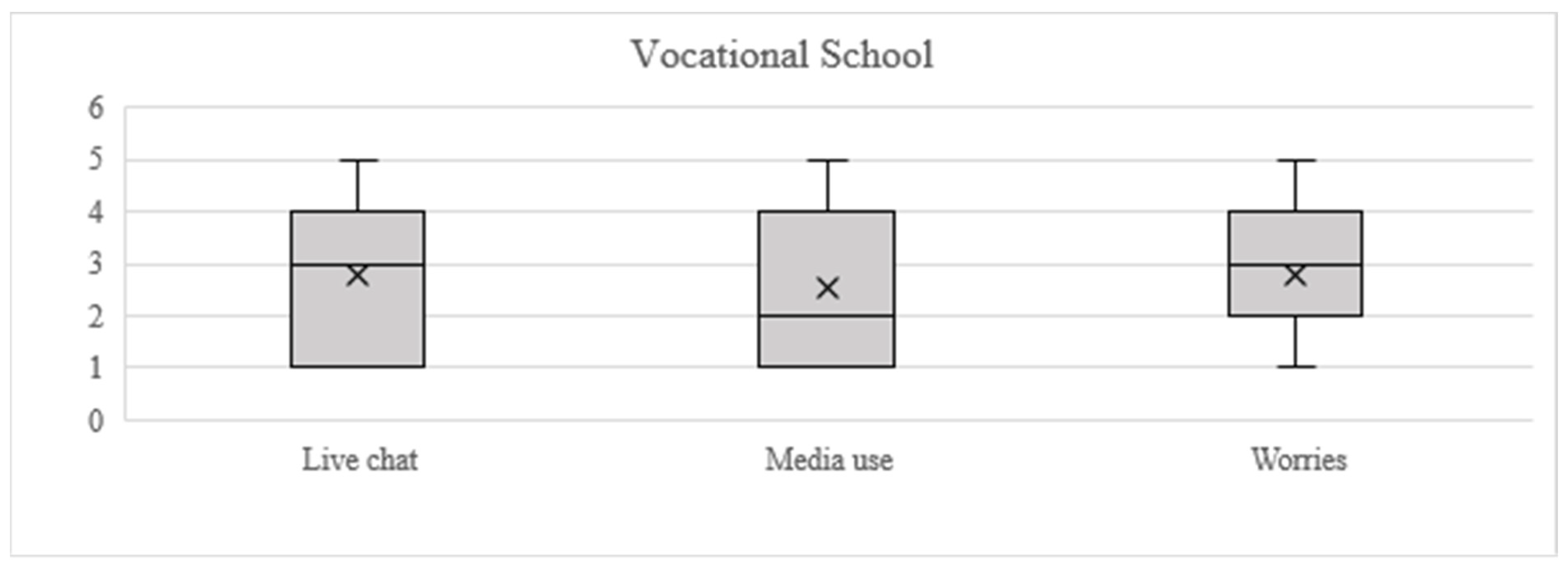
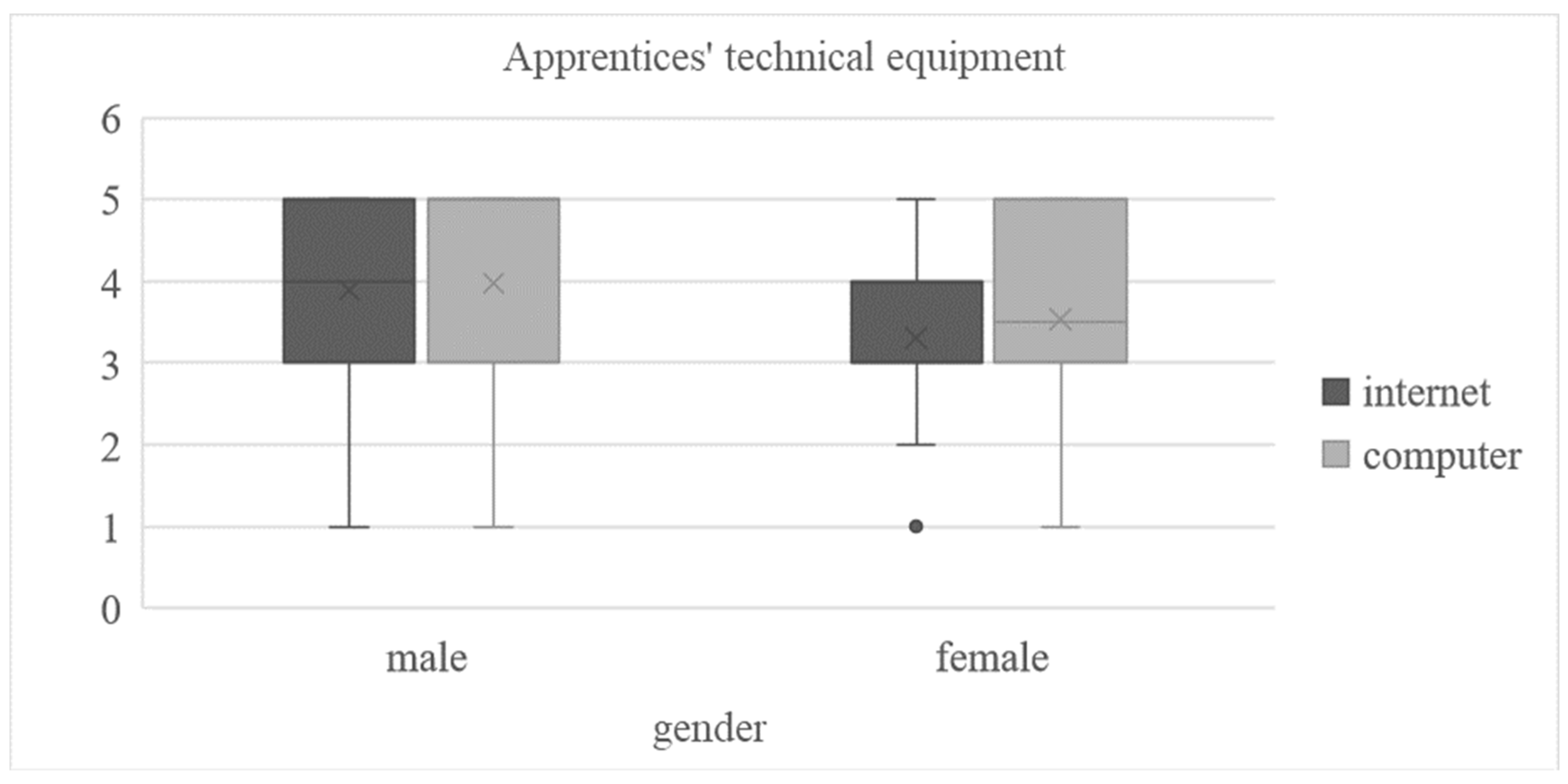
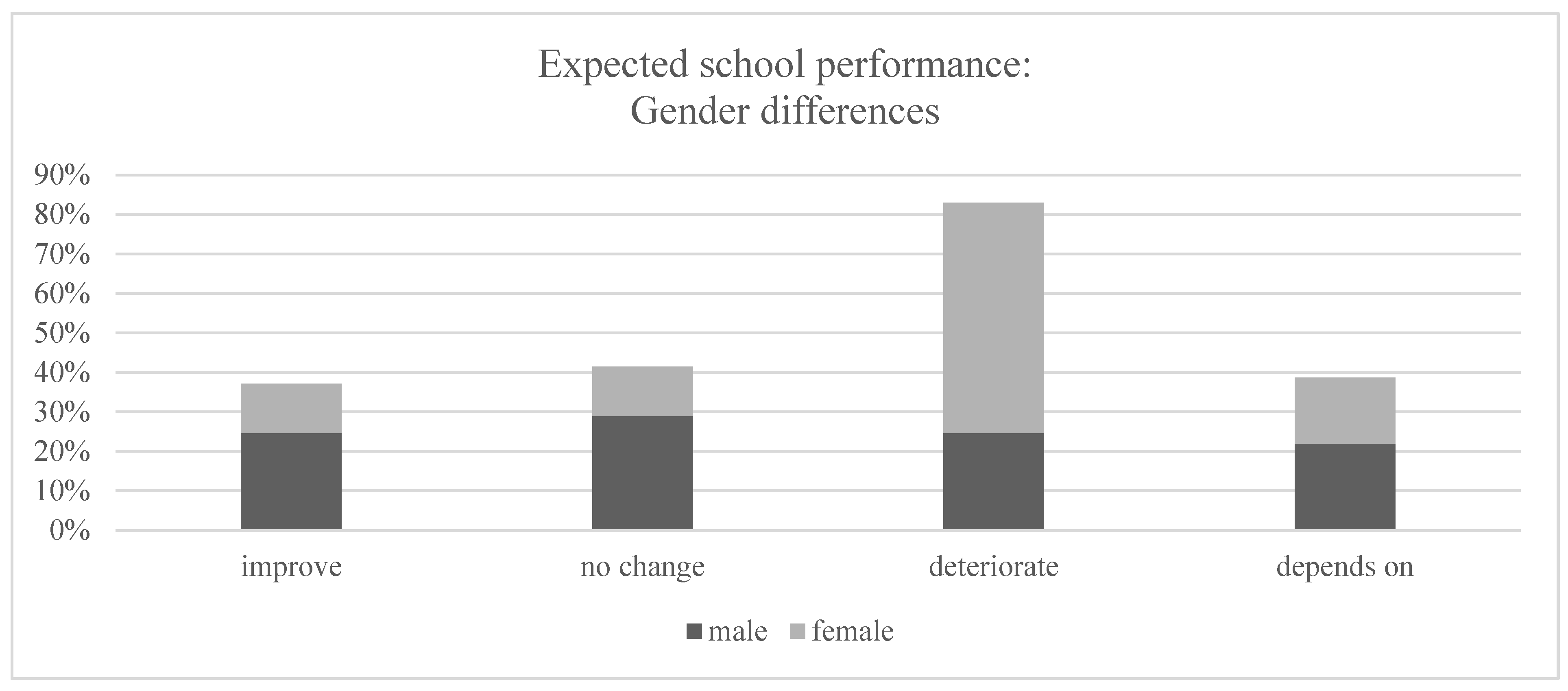
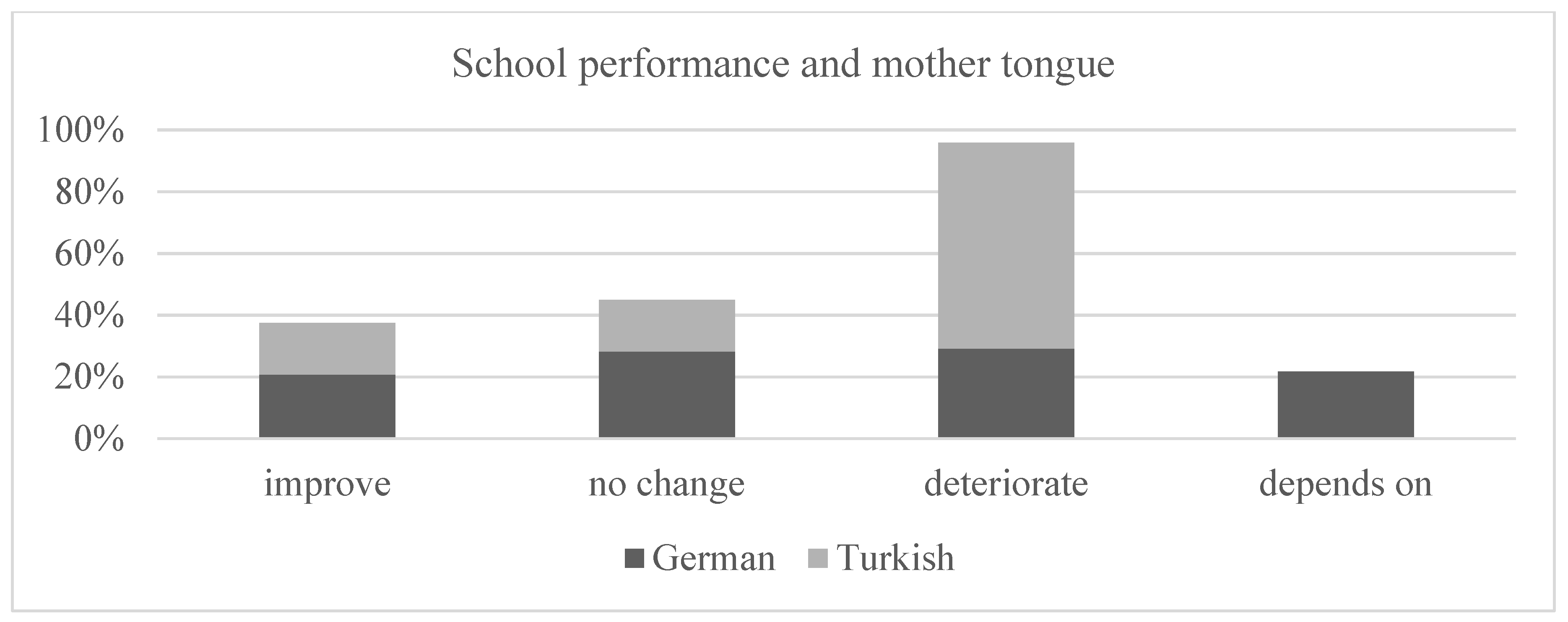
| Sociodemographic Data | Scale | Modus | Median | Mean |
|---|---|---|---|---|
| Age | In years | 19 | 19 | 19.74 |
| min: 16; max: 35 | −3.08 | |||
| Gender | Male | 1 | 80.90% | |
| Female | 17.20% | |||
| Diverse | 1.90% | |||
| School diploma | No secondary school diploma | 3 | 3 | 2.58% |
| Lower secondary school certificate | 30.97% | |||
| Intermediate secondary school certificate | 57.42% | |||
| University of applied sciences entrance qualification | 6.45% | |||
| General university entrance qualification | 2.58% | |||
| Mother tongue | German | 1 | 80.20% | |
| Other language | 19.80% |
| N | Mean | SD | Cohen’s d | ||
|---|---|---|---|---|---|
| Computer | |||||
| male | 117 | 3.97 | 1.417 | 0.147 | 0.317 |
| female | 26 | 3.54 | 1.174 | ||
| Internet | |||||
| male | 117 | 3.90 | 1.269 | 0.029 * | 0.478 |
| female | 26 | 3.31 | 1.050 |
| Improve | No Change | Deteriorate | Depends on | Total | |||
|---|---|---|---|---|---|---|---|
| Gender | male | frequency | 28 | 33 | 28 | 25 | 114 |
| % of gender | 24.6% | 28.9% | 24.6% | 21.9% | 100.0% | ||
| female | frequency | 3 | 3 | 14 | 4 | 24 | |
| % of gender | 12.5% | 12.5% | 58.3% | 16.7% | 100.0% | ||
| Total | frequency | 31 | 36 | 42 | 29 | 138 | |
| % of gender | 22.5% | 26.1% | 30.4% | 21.0% | 100.0% |
| Mother Tongue | Absolute Frequency | Proportion in Percent |
|---|---|---|
| German | 134 | 80.2 |
| Albanian | 4 | 2.4 |
| Arabic | 1 | 0.6 |
| Italian | 2 | 1.2 |
| Khmer | 2 | 1.2 |
| Croatian | 1 | 0.6 |
| Kurdish | 3 | 1.8 |
| Polish | 1 | 0.6 |
| Portuguese | 1 | 0.6 |
| Romanian | 1 | 0.6 |
| Russian | 3 | 1.8 |
| Turkish | 14 | 8.4 |
| Total | 167 | 100.0 |
| Improve | No change | Deteriorate | Depends on | Total | |||
|---|---|---|---|---|---|---|---|
| Gender | German | frequency | 22 | 30 | 31 | 23 | 106 |
| % | 20.8% | 28.3% | 29.2% | 21.7% | 100.0% | ||
| Turkish | frequency | 2 | 2 | 8 | 0 | 12 | |
| % | 16.7% | 16.7% | 66.7% | 0.0% | 100.0% | ||
| Total | frequency | 24 | 32 | 39 | 23 | 118 | |
| % | 20.3% | 27.1% | 33.1% | 19.5% | 100.0% |
| Technical equipment and the organization in the vocational school |
|
| Impact on academic performance |
|
Publisher’s Note: MDPI stays neutral with regard to jurisdictional claims in published maps and institutional affiliations. |
© 2021 by the authors. Licensee MDPI, Basel, Switzerland. This article is an open access article distributed under the terms and conditions of the Creative Commons Attribution (CC BY) license (https://creativecommons.org/licenses/by/4.0/).
Share and Cite
Hochmuth, M.; Geßler, A.N.; Seyffer, S.; Frey, A. Challenges in the Digitization of Apprenticeships during the Coronavirus Pandemic: Who Needs Special Assistance? Sustainability 2021, 13, 11701. https://doi.org/10.3390/su132111701
Hochmuth M, Geßler AN, Seyffer S, Frey A. Challenges in the Digitization of Apprenticeships during the Coronavirus Pandemic: Who Needs Special Assistance? Sustainability. 2021; 13(21):11701. https://doi.org/10.3390/su132111701
Chicago/Turabian StyleHochmuth, Melanie, Alina Nadine Geßler, Silke Seyffer, and Andreas Frey. 2021. "Challenges in the Digitization of Apprenticeships during the Coronavirus Pandemic: Who Needs Special Assistance?" Sustainability 13, no. 21: 11701. https://doi.org/10.3390/su132111701
APA StyleHochmuth, M., Geßler, A. N., Seyffer, S., & Frey, A. (2021). Challenges in the Digitization of Apprenticeships during the Coronavirus Pandemic: Who Needs Special Assistance? Sustainability, 13(21), 11701. https://doi.org/10.3390/su132111701






